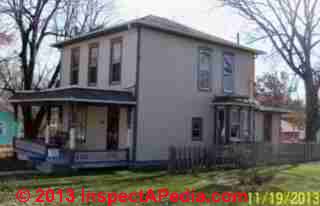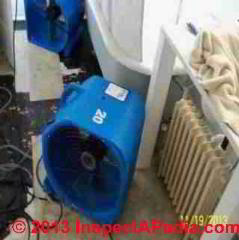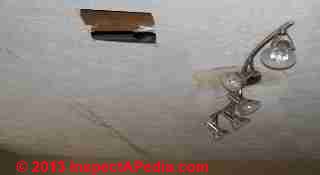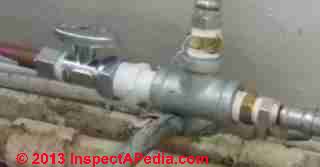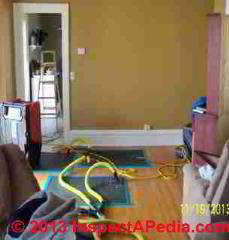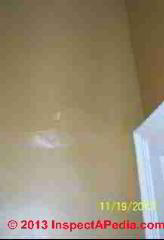 How to Work With the Flood Insurance Company & Water Damage / Mold Contractors
How to Work With the Flood Insurance Company & Water Damage / Mold Contractors
Flood Damage Repair Guide FEMA/ARC expanded & annotated
- POST a QUESTION or COMMENT about how to respond to building flooding, advice from FEMA, the American Red Cross, and other experts
How to work with the flood insurance company, homeowners's insurance company & water damage contractors if you are unsure about the workmanship or scope of dry-out, cleaning, demolition & repair following building damage from water, fire, flooding, hurricanes, earthquakes or similar disasters.
This article series includes and expands on information on avoiding or minimizing mold damage adapted and expanded from Repairing your Flooded Home, American Red Cross & FEMA & from additional expert sources.[1] NOTICE: neither the ARC nor FEMA have yet approved the additions & expansions we have made to the original document.
InspectAPedia tolerates no conflicts of interest. We have no relationship with advertisers, products, or services discussed at this website.
- Daniel Friedman, Publisher/Editor/Author - See WHO ARE WE?
How to Work With a Contractor for Reconstruction of a Building after Wetting or Flood Damage
You may need a contractor to help you rebuild, especially to handle the difficult jobs such as foundation repair and electrical work. If you have been satisfied with work done by licensed local contractors, try them first. If they cannot help you, ask them for recommendations.
If you must hire a contractor you do not know, talk to several contractors before you sign anything. Reputable contractors would agree that you should take the following steps:
- Check on the firm’s reputation. The local Better Business Bureau, home builders association, or building trades council are excellent sources. Ask if the firm has had unanswered complaints filed against it.
- Ask for proof of insurance. Be sure the contractor has disability and worker’s compensation insurance. If the contractor is not insured, you may be liable for accidents on your property.
- Ask for references. Contractors should be willing to provide names of previous customers. Call some of the customers and ask if they would hire the contractor again.
- Ask for a written estimate. Check it to make sure it includes everything you expect the contractor to do. Some contractors charge a fee for an estimate, which is understandable because they have plenty of work to do after a flood.
- Ask for a contract. The contract should be complete and clearly state all the work, the costs, and the payment schedule. Never sign a blank contract or one with blank spaces. If a lot of money is involved, it may be worth your while to have an attorney look at the contract before you sign it.
- Ask for any guarantees in writing. If the contractor provides guarantees, they should be written into the contract, clearly stating what is guaranteed, who is responsible for the guarantee (the dealer, the contractor, or the manufacturer), and how long the guarantee is valid.
- Obtain a copy of the final signed contract. Once signed, it is binding on both you and the contractor.
- Don’t sign off nor make final payment before the job is finished. Don’t sign completion papers or make the final payment until the work is completed to your satisfaction. A reputable contractor will not threaten you or pressure you to sign if the job is not finished properly. Areas recuperating from floods are often prime targets for less- than-honest business activities. Building codes often require that work be done only by licensed contractors. Some building departments and trade associations keep lists of contractors who work in the community.
Points to remember about hiring a contractor
- Be cautious when contractors you don’t know offer “special deals” after a disaster or want to use your home as a “model home.”
- Ask for complete financial details in writing and for an explanation of any differences from regular prices. Sales are worthwhile and they do exist, but be sure you are getting the services and products you are paying for.
- Do not sign a contract when a salesperson has pressured you. Federal law requires a three-day “cooling off” period for unsolicited door-to-door sales of more than $25. If you want to cancel such a contract within three business days of signing it, send your cancellation by registered mail. Other types of sales may have contracts with different cancellation clauses.
- Beware if you are asked to pay cash on the spot instead of a check made out to the contracting company. a reasonable down payment is up to 30% of the total cost of the project.
- Make sure your contractor calls you or a qualified observer to inspect work before it is covered over. Shoddy work on sewers or basement walls will be hidden from view, and you won’t know if there is a problem until the next flood. Most building departments will want to inspect electrical and plumbing lines before the walls are covered with wallboard or paneling. If you are a victim of fraud or have problems with a less than reputable contractor, the state or local consumer protection office or public attorney should be able to tell you what to do.
Reader Question: I am worried that my contractor or insurance company took ineffective shortcuts when drying out my home after a leak & flooding
The following exchange began with a discussion of water damage to a pressed tin ceiling (METAL CEILINGS ALUMINUM & TIN) and continues here with a discussion on working with the insurance company and contractor involved in drying out a building following water damage.
[Click to enlarge any image]
This house was built in 1886 and it is a house that we bought for our daughter 6 months ago. It has been maintained
Very well. This water loss occurred on 11-09-13 , my daughter had been gone from the home for three hours when she came home.
And discovered it. A water valve to the bathtub burst in the upstairs bathroom. Looking at this picture the bathroom would be to the right of the second
Upper window above the bay window by the wooden fence.
The bay window is a breakfast nook in the main floor kitchen which is directly below the upstairs bathroom.
The water went through the bathroom floor , through both ceilings in the kitchen and traveled through to the basement.
The water also traveled into the living room and entry way to the home.
If you don’t mind I am going to attach photos so you can get a visual.
The insurance company hired a “One Man” outfit to respond. He used a couple of fans a one humidifier to dry out everything.
He placed his equipment early Sunday morning 11-10-13 and came and removed it the following Tuesday 11-12-13 morning. He never used micro ban , sanitized anything etc.
He is the one that cut out the small square from the dropped ceiling in the kitchen in order to try and dry the ceiling kitchen ceiling [photo at left]. The cupboards in the kitchen were full of water.
The ceiling right to the right is where the wiring you mentioned goes to. Above this ceiling is the two fans that are in the above photo.
I was in St Louis when it happened and did not get home until late Wednesday night 11-13-13.
My daughter is 25 years old and single and knows nothing about insurance or water losses.
I looked at the house and notice it was still sopping wet so I called her adjuster and “Paul Davis Restoration” to do a mutual
Inspection that same day (Thursday 11-14-13). Paul Davis to the adjuster that he had to start all over because the home was not
Dried out properly. Neither the adjuster nor the person for the restoration company looked above the dropped ceiling.
The restoration company could not get to the house until the following Monday 11-18-13. So that was another 5 days of leaving the home wet !
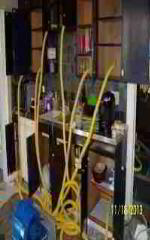
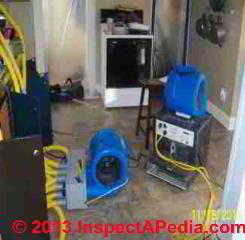
As you can see in this photo they cut holes into the kitchen cupboards and started pumping hot air into the plaster wall that has the living room on the other side. The water had traveled down that wall and leaked into the living room and the wood floors are already cupping so the put down mat’s and are sucking the hot air up that is being pumped into the walls and ran it through a humidifier. This is below the kitchen ceiling.
[DF note: see our comments below about th use of water extraction methodds. Particluarly as shown in these photos, blowing air "one way" into a wall cavity, like blowing up a balloon, is not likely to be effective.]
LIVING ROOM OPPOSITE SIDE OF THE KITCHEN
PLASTER BUBBLING ON WALL BY KITCHEN TO THE LEFT OF THE DOOR IN PRIOR PHOTO
[DF note: I find that while it is by no means "mold proof", plaster is slower to support growth of a large mold reservoir than drywall or other wood and paper materials.]
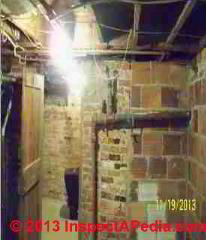 ...
...

WATER "DAMAGE" IN BASEMENT BELOW KITCHEN
[DF Note: I do not see water damage nor visible mold in the two photos above. I do see water stains, telling us something about the passage of water over these surfaces. A water stained-surface may be a cosmetic issue, and a diagnostic clue, but the stained area itself, such as at above right, would not be considered a hazard. Of course there may be mold growth developing that we can't see in these photos.]
I used a ladder and stuck my camera up above the dropped ceiling and when I found out what was there I took about 60 photos. I have numerous concerns about the potential “Hidden” damage above the dropped ceiling. I am concerned about “Mold” There could still be water sitting above the pressed tin
Ceiling. Could it be in the grove areas where the tin was pressed. I don’t have any idea what the tin is connected to? I have no idea if what the tin is connected to was in fact dried out. I am concerned about all this air flow that is circulated through the lead paint and potential asbestos dropped ceiling tiles.
They had this house at 99 to 100 degrees for 4 day’s it melted my daughters make up and lip stick ! They have never even checked above the lowered ceiling to see if it is dry above it.
They have used their “Moisture Testers” on the kitchen walls but the “Pressed Tin” ceiling is 1’ 5 “ above the dropped ceiling. They do not even have access to the tin ceiling other than
From the little hole the first guy cut out. That ceiling is full of paint chips. I am worried if they even know how to address the water that ran over the lead paint and throughout the rest of the house. The Peeling paint will continue to drop onto the lowered ceiling etc.
The insurance adjuster had called the area above the dropped ceiling an “Abandoned Ceiling” Stating they do not owe for that damage. He states that the dropped ceiling is a sufficient “ Encapsulation” to protect the home owner from any potential “Harm” Do you agree with that ? The adjuster nor the contractor has even looked up in the attic until I
Showed them my photo’s. Outside of looking at my photos they have done nothing to address the potential health issues and or physical damage above the dropped ceiling and below the upper floor water damage. No one has even checked the dropped ceiling tiles to see if they are Asbestos. Because of it being 99 to 100 degrees in the home for four day’s , I am worried about my daughters canned food, other food, Refrigerator motor ( would the heat cause it to run continually?) TV , electronics in general. I have asthma I am worried about the mold , the adjuster advised me they don’t have to micro ban because they dried it out in a timely manner. REALLY ?
There were huge delays in drying the home out and I think we could still have water trapped in the top part of the pressed tin. Is the top part to the pressed tin flat ? Or is there indentations where the tin has been pressed? I do not know.
I am so grateful for your time..., I have a lot of concerns for my daughters health because of this insurance company trying to save a couple of bucks at my daughters expense. I hope to be a Grandfather someday. They have not started any repairs to date other than the drying process, I might need to get an attorney? Please let me know your thoughts, I can send more photos I took about 60.
Reply: How to Figure Out If Water & Mold Problems Remain following a questionable dry-out or "de-watering" procedure
To get our arms around this question, or maybe minds, we need to know:
- What got wet - throughout the building, that is, where exactly did water go, where might humidity from water or wet materials have penetrated to problematic levels (insulated cavities for example), what types of materials were wet.
- How long it stayed wet (most likely some things are still wet)
- What other conditions may have affected the risk levels (temperatures, air movement, operation of mechanical systems like central air conditioning or warm air heat)
- What are the risks and harm that are likely (mold, lost insulation R-value, unsafe electrical wiring, damaged controls)
at BUILDING DRY-OUT PROCEDURES we describe the proper steps in drying out a building after flooding, and
at MOLD CONTROL, FLOOD RESPONSE we outline effective steps to prevent mold growth following an event that soaks or wets a building.
OPINION: some remarks that you report from the insurance company, like about the drop ceiling protecting you from any mold reservoirs, are quite mistaken and are easily shown to be so by citing current codes and standards about air movement through suspended ceilings - -see the energy codes notes in the article
at CEILINGS, DROP or SUSPENDED PANEL.
For example, should a building cavity develop a large (more than 30 sq.ft. contiguous) Aspergillus sp. or Penicillium sp. mold reservoir, those tiny spores, down to about 1 micron, travel through the building in air about as effectively as would a gas or VOC. And down-drafts can in some conditions pull contaminants out of building ceilings & attics into the occupied space.
Don't panic, but do not sign off agreeing that proper work has been performed. Perhaps I should look at all of your photos and reports and documents. No costs or fees are involved (on my part) provided the amount of time and work doesn't sink me.
Reader follow-up:
One of my main questions and concerns is the fact that the insurance company is saying that in their professional opinion: The dropped ceiling is an adequate “encapsulation” to contain any harmful debris that might result from the lead paint droppings and or air circulation. They want to just fill back in the little square they cut out and they say there is no more exposure to lead and or mold if they do that.
What about all the water that has already ran through that lead paint and then onto the kitchen floor etc. What about the drying out process where it was 100 degrees in the house with all those fans for four days , what about the potential mold?
I am concerned about my daughters health and mine when I visit her. She only lives 9 miles away. We visit her all the time. Now we are in limbo because I don’t know what to do, there has been no repair work done now they put a piece of plastic over the hole in the dropped ceiling is all.
Reply: comments on procedures to dry out or de-water a home after a flooding or wetting event
Comments are interspersed with a quote of your text. As I emphasize, with complete photos and copies of reports you've been provided, while it's no substitute for an expert on-site inspection, often I can comment usefully and further than just what's below.
How Quickly Do We need to Dry Out the Home?
So that was another 5 days of leaving the home wet !
We find that if we can completely dry out a building in 24-48 hours after it is soaked by a flood, bust pipe, fire, ice dam leak or other similar event, we have a good chance of avoiding large costly mold reservoirs in the affected building cavities such as ceilings, walls & floors. Just how much time we actually have depends on other variables including (but not limited to)
- The ambient indoor & outdoor temperatures - lower or colder temperatures slow the growth of most molds
- The building materials involved
- Just where water went - what got wet
- The total amount of wetting - how much water and how wide spread was it in the building
Does a Suspended Ceiling Protect Building Occupants from Mold in Ceiling Cavities?
One of my main questions and concerns is the fact that the insurance company is Saying that in their professional opinion: The dropped ceiling is an adequate “encapsulation” to contain Any harmful debris that might result from the lead paint droppings and or air circulation. They want to just fill back in the little square they cut out and they say there is no more exposure to lead and or mold if they do that.
That statement is flat and completely incorrect. It also violates both building codes and standards that address building air movement and energy. You can understand better why the statement you report is a nonsense reply, unsupported by expert research or independent data by seeing the codes and standards and explanation about adding insulation in suspended ceilings found in the link I gave above.
Keep in mind that we don't know the actual risk - as we don't know what mold reservoirs, if any, are actually present in the building. I'll say more about that later. But the concept of what you were told was ... well ... nonsense.
Check the energy codes cited in the article section titled Energy Code vs Effects of Insulation Installed in Suspended Ceilings In short, a suspended ceiling is NOT an air barrier and NOT a particle barrier and worse, serves as a growth reservoir for mold or other pathogens if it has been flooded and not properly cleaned.
Lead Paint Hazards in Older Flooded or Water-Damaged Homes
What about all the water that has already ran through that lead paint and then onto the kitchen floor etc.
The lead hazard from water containing leached lead and that ran on accessible building surfaces would be addressed by cleaning those surfaces.
Watch out: However in an old building with lead paint there may indeed be lead paint hazards that need to be addressed and that normally have nothing to do with the insured loss event - at first glance. But at second glance we run into a mess: a competent, informed contractor will not perform demolition, cutting, sawing, sanding, renovations where lead based paints are known or suspected to be installed without an expert assessment and if necessary a lead abatement plan. Failure to follow those precautions violates laws in some states & provinces and in any event risks putting the contractor, employees, and building occupants at risk of lead poisoning.
Are Sanitizers & Fungicidal Sealants Required after a Building Flood?
The adjuster advised me they don’t have to micro ban because they dried it out in a timely manner. REALLY ?
Really, yes. I agree completely with your insurance adjuster on this one. Mycologists (Haines et als.) explain that in proper mold remediation the requirement is to remove the mold, not to kill it. I add that following cleaning off or removing the mold we need to fix the cause of its growth. Sanitizers, biocides, fungicides, and fungicidal sealant paints are the icing on the cake and are not necessary if the proper steps are taken in the first place, and are ineffective if the proper steps were not taken.
I agree that applying a sanitizer or biocide can reduce airborne and surface-borne moldy dust after a mold remediation project, but those mold sources are effectively trivial and have little bearing on ongoing building health unless the cleanup was improper and a large quantity of moldy debris and dust remained in the building.
I also agree that applying a fungicidal sealant can impede future mold growth on some materials by two means: first, for as long as it remains chemically effective the biocide may retard fungal growth, and second, a paint that seals a surface against moisture uptake improves the moisture resistance of the material and thereby impedes future mold growth. But mold resistant is not mold-proof. If we don't fix building leaks, for example, mold contamination will return. In fact I have observed fresh mold growth sprouting on a surface that had just been painted with a fungicide. The application was over an unclean surface in a building that had not been adequately remediated.
Effectiveness of Water Extraction Equipment & Non-Destructive Dry-Out Methods
The insurance company hired a “One Man” outfit to respond. He used a couple of fans a one humidifier to dry out everything.
What about the Drying out process where it was 100 degrees in the house with all those fans for four days , what about the potential mold?
The drying out process you described could not be considered effective nor reliable. In the course of inspecting buildings for mold and moisture since 1986 I have not once found that superficial dryout (fans and dehumidifiers placed in a flooded building) was effective at preventing mold growth in building cavities that were soaked. Some examples are found at
HIDDEN MOLD in CEILINGS / WALLS
I well understand the appeal of an octopus warm air blower trying to push air through building cavities, as it avoids more costly demolition. However in every building that I have investigated (n = 14) where this process was used, I found that in one or more significant wall or ceiling cavities there was not sufficient air-flow to dry out the cavity sufficient to prevent a subsequent and severe growth of a contaminated mold reservoir. The bubbled plaster you cite might be an example of how workers can be fooled when using this procedure.
Little holes and hoses have not produced reliable, good results in my experience.
Leaving baseboard or floor trim in place is another common mistake in flooded buildings. We completely dried the walls and floors in several rooms whose floors had been soaked by water running from a burst toilet. But as much as a week later I could pull off baseboard floor trim and find that its back surface and the drywall behind it were soaked (and developing mold).
That is not to assert that every location and every material in building cavities becomes a dangerous mold reservoir. The extent of mold growth in closed building cavities that were wet depends on the building materials present. For example plaster is less mold-friendly than drywall, and cellulose loose-fill or blown-in insulation is less mold-growth-conducive than fiberglass.
An expert approach to the question would require the steps I summarized in my first note, followed by thoughtful and limited invasive inspection and testing of the most-suspect building cavities.
What to Discuss with Your Insurance Company who says "don't worry about it!"
You might want to make clear to the insurance company in writing that there is evidence, visual, procedural, & technical that
- Proper and effective dry-out procedures were not followed
- Advice telling you "not to worry" that a suspended ceiling protects building occupants from contaminants such as a ceiling mold reservoir is technically and professionally unsound
- There is reasonable expectation that risks remain that could involve future health injuries to present or future building occupants and possibly significant health-related costs as well as proper building clean-up related costs.
- The proper way to reassure the building occupants and to manage reasonable risks to all parties concerned is to have a highly-competent, independent expert interview occupants, obtain building leak history, review the steps taken to date, assess and investigate the most serious risk areas and building cavities, and if appropriate, write a building remediation plan that is competent.
- That consultant must be experienced in flood and water damage and mold damage assessment, must understand building science such as how water & air move in buildings, should understand basic mycology (how mold grows in buildings) and should be experienced and trained in proper use of building inspection methods, tests & tools. And critically, s/he must have no business nor financial relationship with the insurance company nor with the contractors who ultimately will perform any further work that is needed.
Hire an Independent Insurance Adjuster?
Finally, if the insurance company is not taking appropriate and reliable steps the insured may need to hire an independent adjuster.
I hesitate to recommend hiring an attorney or to take the step of hiring an independent insurance adjuster if it can at all be avoided, because it immediately changes the insurance company's view of the insured and the situation as a "hostile" one and their cooperativeness stops. Other concerns with that approach is that repair work is slowed or stops, total costs may escalate, and delays in taking proper dryout and clean-up action in a building often ultimately significantly increase the total repair cost.
On the other hand, if people are not being responsible anyway, that may be the only course since if proper repair work is not being performed, all of those worries exist in the first place.
Do Not Rely on an Air Test to Clear This Building
Watch out: do not accept a simple "air test" of the building as evidence that no further investigation or work are needed. Air tests alone, without the more thoughtful assessment I've been describing would be quite unreliable not only because the test results vary by orders of magnitude from minute to minute based on many factors but also because the development of a problematic mold reservoir that needs attention may not appear immediately after the project you describe, but could be severe days or weeks later.
Does Water Extraction Usually Work to Prevent Mold?
 The elevated temperature that worried you is a procedure intended to improve the speed of dry-out of a wet building. Combined with dehumidification and more aggressive procedures it can be an effective tool in the post-flood remediation procedure.
The elevated temperature that worried you is a procedure intended to improve the speed of dry-out of a wet building. Combined with dehumidification and more aggressive procedures it can be an effective tool in the post-flood remediation procedure.
But raising the temperature without also adequately dehumidifying will simply move moisture out of the wet area into other areas including possibly cooler building cavities where it condenses to wet insulation or invite mold growth. In fact I think I'd prefer to see the building under negative air pressure when this approach is taken.
And then there is field experience with the results of the water extraction machines you described as blowing air through holes cut in cabinets, walls, and ceilings.
I have found it just about impossible to prevent mold growth behind or under cabinets in a flooded area without removing them completely, and promptly. We just cannot move enough air uniformly across all of the involved surfaces and through materials like insulation that block airflow, and there is a secondary risk that not all of the affected cavities are even blown with air. For example in an older home like the one in your photo, fire blocking and diagonal bracing that block airflow in wall cavities may be outside the imagination of the water extraction contractor.
In one of the most disappointing SNAFUs I investigated for a large insurance company, their contractor had used the same approach as that shown in your photos - a "water extraction" company ran heat, dehumidifiers, and blowers trying to push air through small holes in building cavities following a flooding event. Immediately after their "job" everything looked great to the contractor who told the insurance company the job was done successfully.
The mold photo shown here (not from your building) is from that home. This is what the wall cavity looked like two weeks after the water extraction company "extracted".
Workers returning to the home to paint and install new carpeting complained of respiratory issues when in the home. It took just minutes to cut open an interior partition wall at the bottom and top of which I saw round cut openings for the original dryout machine.
The wall-cavity side of drywall was absolutely thick with multiple genera/species of molds and yeasts. In my OPINION the total extent of demolition and cleaning that was ultimately needed to clean and restore that home was much greater than it would have been had a more experienced and thoughtful contractor dried out the building in the first place by making appropriate strip cuts on floors and ceilings.
...
Continue reading at Step 9. FLOOD & STORM INSURANCE - separate article - Protect yourself from the next flood with flood insurance, a flood response plan, and community flood protection programs.
Or see these
Recommended Articles
- CHOOSE a FLOOD DAMAGE RESTORATION or MOLD REMEDIATOR
- MOLD PRODUCTS, INEFFECTIVE
- OZONE MOLD / ODOR TREATMENT WARNINGS
- RENTERS & TENANTS ADVICE for UNSAFE or UNHEALTHY HOME
Suggested citation for this web page
FLOOD REPAIR CONTRACTORS at InspectApedia.com - online encyclopedia of building & environmental inspection, testing, diagnosis, repair, & problem prevention advice.
Or see this
INDEX to RELATED ARTICLES: ARTICLE INDEX to BUILDING DAMAGE, DISASTER, REPAIRS
Or use the SEARCH BOX found below to Ask a Question or Search InspectApedia
Or see
INDEX to RELATED ARTICLES: ARTICLE INDEX to BUILDING STRUCTURES
Or use the SEARCH BOX found below to Ask a Question or Search InspectApedia
Ask a Question or Search InspectApedia
Questions & answers or comments about rebuilding and floodproofing a building after a flood or other disaster.
Try the search box just below, or if you prefer, post a question or comment in the Comments box below and we will respond promptly.
Search the InspectApedia website
Note: appearance of your Comment below may be delayed: if your comment contains an image, photograph, web link, or text that looks to the software as if it might be a web link, your posting will appear after it has been approved by a moderator. Apologies for the delay.
Only one image can be added per comment but you can post as many comments, and therefore images, as you like.
You will not receive a notification when a response to your question has been posted.
Please bookmark this page to make it easy for you to check back for our response.
IF above you see "Comment Form is loading comments..." then COMMENT BOX - countable.ca / bawkbox.com IS NOT WORKING.
In any case you are welcome to send an email directly to us at InspectApedia.com at editor@inspectApedia.com
We'll reply to you directly. Please help us help you by noting, in your email, the URL of the InspectApedia page where you wanted to comment.
Citations & References
In addition to any citations in the article above, a full list is available on request.
- [1] REPAIRING YOUR FLOODED HOME [PDF], American Red Cross & FEMA: Federal Emergency Management Agency, FEMA PO Box 2012, Jessup MD 20794-2012. Printed copies of this book are available from the American Red Cross, from your local Red Cross chapter, or by writing to the address above. Web search 10/4/2010, original source: http://www.redcross.org/www-files/Documents
/pdf/Preparedness/file_cont333_lang0_150.pdf - [2] The following are available free from:
Federal Emergency
Management Agency
Attn: Publications
P. O. Box 2012
Jessup, MD 20794-2012
- In addition to citations & references found in this article, see the research citations given at the end of the related articles found at our suggested
CONTINUE READING or RECOMMENDED ARTICLES.
- Carson, Dunlop & Associates Ltd., 120 Carlton Street Suite 407, Toronto ON M5A 4K2. Tel: (416) 964-9415 1-800-268-7070 Email: info@carsondunlop.com. Alan Carson is a past president of ASHI, the American Society of Home Inspectors.
Thanks to Alan Carson and Bob Dunlop, for permission for InspectAPedia to use text excerpts from The HOME REFERENCE BOOK - the Encyclopedia of Homes and to use illustrations from The ILLUSTRATED HOME .
Carson Dunlop Associates provides extensive home inspection education and report writing material. In gratitude we provide links to tsome Carson Dunlop Associates products and services.
- In addition to citations & references found in this article, see the research citations given at the end of the related articles found at our suggested


